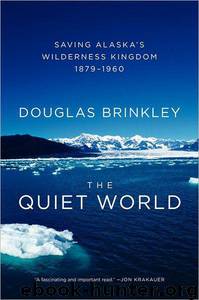The Quiet World: Saving Alaska's Wilderness Kingdom, 1879-1960 by Douglas Brinkley

Author:Douglas Brinkley
Language: eng
Format: mobi, epub
ISBN: 9780062005977
Publisher: Harper
Published: 2011-01-18T00:00:00+00:00
III
World War II transformed Alaska, seemingly overnight, from a backwater territory to a major strategic asset that was well worth defending. Following the attack on Pearl Harbor the Japanese navy actually seized two outer Aleutian islets—Attu and Kiska—as part of its North American campaign. The Roosevelt administration quickly established a military command in Alaska and moved defense forces to Adak, Dutch Harbor, and Cold Bay. Because the U.S. government censored news from Alaska in the 1940s, this campaign is called the “forgotten war.” The United States engaged Japanese troops in the Aleutians from June 3, 1942, to August 15, 1943. The wind and fog were obstacles for both sides. Many B-24 pilots, in fact, described the Aleutian campaign as a three-sided battle waged between the United States, Japan, and the uncooperative weather.28 Samuel Eliot Morison, in his magisterial volume History of United States Naval Operations in World War II, wrote that the Aleutians were the “Theater of Military Frustration.”29
After World War II ended, the U.S. armed forces’ presence in Alaska declined dramatically, from 152,000 troops in 1943 to 19,000 in 1946.30 During the war, the U.S. government had spent more than $1 billion on Alaskan infrastructure projects like building the 1,523-mile Alaska-Canada Highway and modernizing Alaskan railroads. The overland road built from Delta Junction (southeast of Fairbanks) to Dawson Creek (in British Columbia) forever changed how Alaska’s lands would be managed. Huge D-8 Caterpillar bulldozers with enormous cutting blades uprooted towering spruces. Gravel was hauled in dump trucks and other vehicles from alluvial riverbeds and hillsides. When it rained or snowed, four-wheel-drive convoys often got stuck in mud craters and impassable ravines.31
The U.S. Navy also dramatically improved Alaska’s docks, wharves, and breakwaters. Pan American Airways had introduced a commercial link between Seattle and Juneau. Alaska was ready for business. As more and more civilians moved to the territory, the postwar movement to reinstate the timber industries swelled. Both of Theodore Roosevelt’s great national forests—the Tongass and Chugach—were now under siege. During the war, also, the U.S. Bureau of Mines had started surveying Alaska’s North Slope for oil. Reports of seepage between Cape Simpson and Point Barrow were becoming commonplace. Congress gave a $1 million grant to begin oil extraction work at the Naval Petroleum Reserve on November 4. A big question was whether oil drilling was feasible in the subzero Arctic conditions. By September 1945 Alaskans were saying that Point Barrow was located at one of the world’s great oil fields. Secretary of the Interior Ickes wrote to an oil booster in Seattle, “Time alone will show whether there is oil . . . and, if so, what its quality and quantity may be.”32 But Ickes was merely stalling. The U.S. Navy was all over the North Slope, considering how best to drill Unimat Mountain along the Colville River. Seabees were busy with pipeline mitigation issues. By late 1945 Secretary of the Navy James Forrestal said that the U.S. government was ready to invest $150 million in Arctic Alaskan oil. Seabees drilled the first well that year.
Download
The Quiet World: Saving Alaska's Wilderness Kingdom, 1879-1960 by Douglas Brinkley.epub
This site does not store any files on its server. We only index and link to content provided by other sites. Please contact the content providers to delete copyright contents if any and email us, we'll remove relevant links or contents immediately.
| African Americans | Civil War |
| Colonial Period | Immigrants |
| Revolution & Founding | State & Local |
Cat's cradle by Kurt Vonnegut(15156)
Pimp by Iceberg Slim(14325)
4 3 2 1: A Novel by Paul Auster(12264)
Underground: A Human History of the Worlds Beneath Our Feet by Will Hunt(11997)
The Radium Girls by Kate Moore(11901)
Wiseguy by Nicholas Pileggi(5650)
Perfect Rhythm by Jae(5306)
American History Stories, Volume III (Yesterday's Classics) by Pratt Mara L(5240)
The Fire Next Time by James Baldwin(5225)
Paper Towns by Green John(5065)
Pale Blue Dot by Carl Sagan(4886)
A Higher Loyalty: Truth, Lies, and Leadership by James Comey(4822)
The Mayflower and the Pilgrims' New World by Nathaniel Philbrick(4403)
The Doomsday Machine by Daniel Ellsberg(4398)
Killers of the Flower Moon: The Osage Murders and the Birth of the FBI by David Grann(4368)
The Sympathizer by Viet Thanh Nguyen(4288)
Too Much and Not the Mood by Durga Chew-Bose(4256)
The Borden Murders by Sarah Miller(4216)
Sticky Fingers by Joe Hagan(4086)
